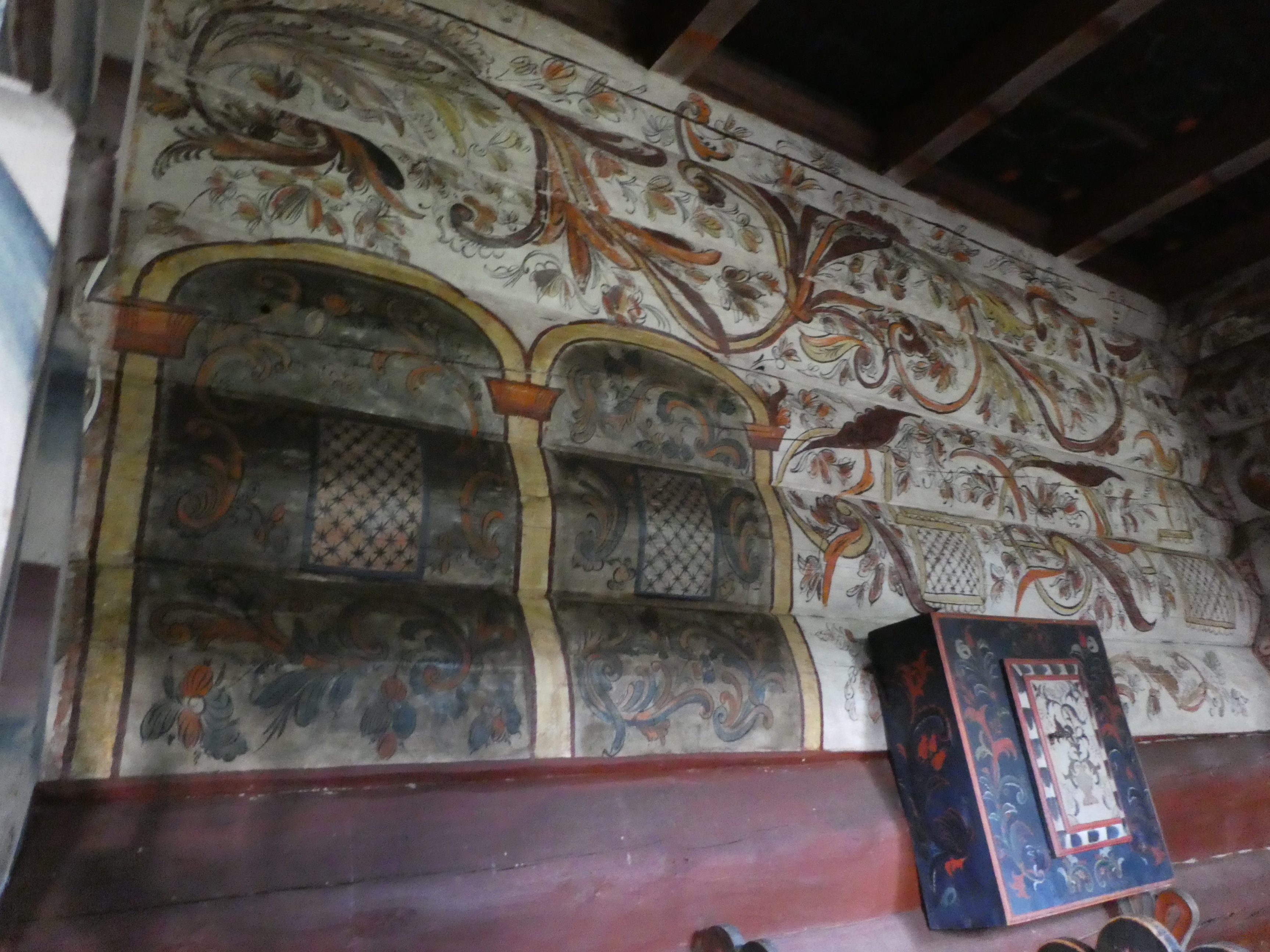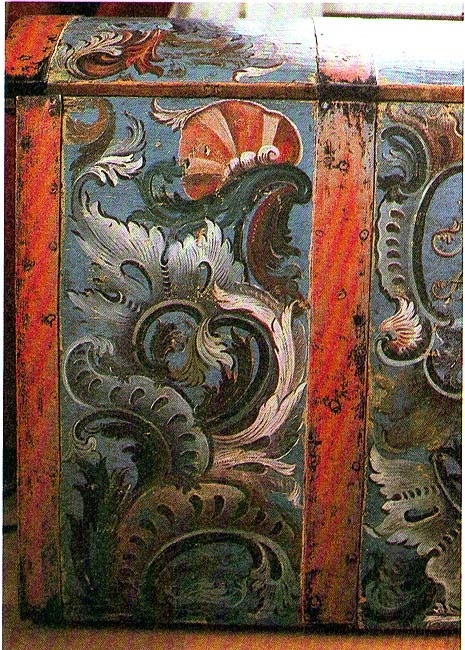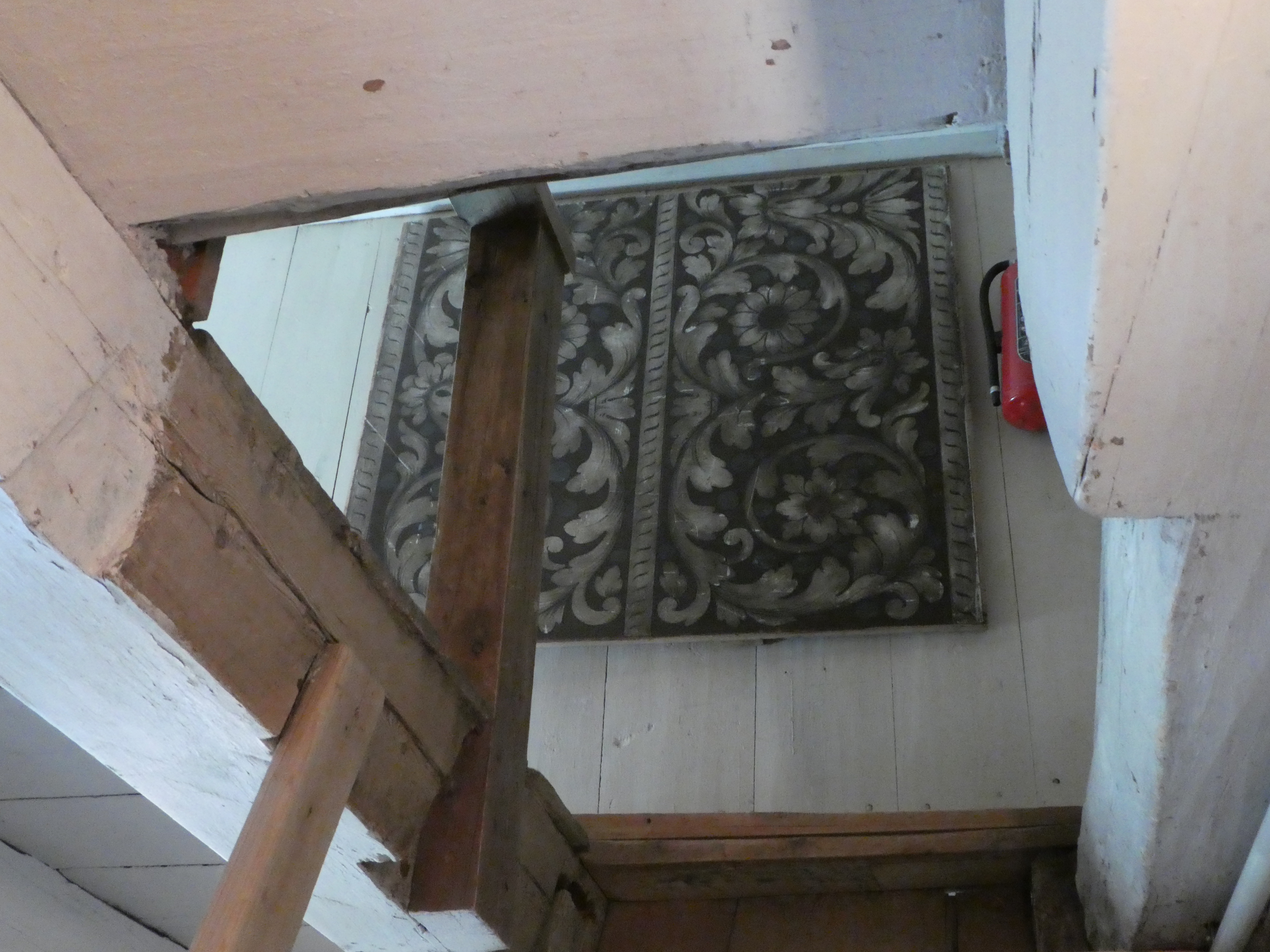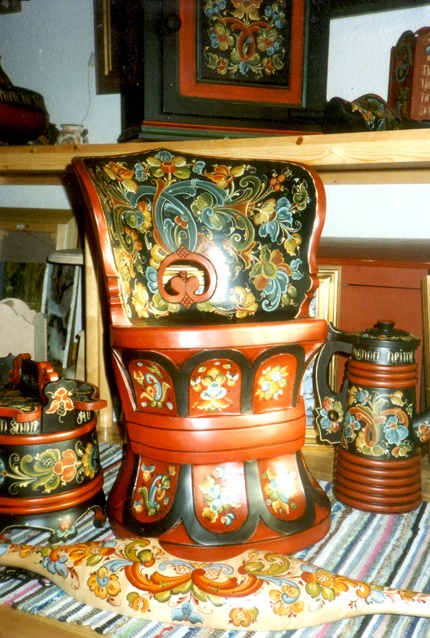History of Norwegian Rosemaling
Rosemaling is a little known traditional art form unique to Norway and is characterized by stylized flowers and ‘c’ and ‘s’ shaped scrolls, inspired by the Renaissance and Acanthus motifs. It is a regional folk art that is timeless and dynamic.

How did Rosemaling evolve?
From rudimentary beginnings in the woodcarving decorations and religious art of the Middle Ages, Rosemaling first appeared in Norway during the Renaissance and Baroque periods of 1550 –1700. Early examples, such as stylized plant motifs and acanthus scrolls, can still be seen in the traditional Norwegian churches dating from that era. In addition, regular trading of goods, with other countries in the Hanseatic League, provided the opportunity for East Asian influences to reach the shores of Norway and this provided further inspiration and influence for development of Norwegian folk art.


International trends in religious and modern art were relatively slow to reach the rural areas of Norway, and it was only as church furniture and fittings, (manufactured by the fashion-conscious urban craftsmen), were gradually installed in the country parishes, that new designs and ideas were introduced to the country folk. Well-to-do farmers and Government officials and the fashion conscious, urban Norwegian elite were more heavily influenced by international trends in decorating and thus Rosemaling was confined mainly to the households and churches in the distant, rural Valleys of Norway.

In this relative isolation, rural Norwegian folk artists adapted the Renaissance inspired religious motifs and changed it to suit their own purposes. Over time, this folk art developed into an original style that evolved into a new art-form, with individual characteristics pertinent to each Valley. Between 1700 -1850, lavishly painted objects were often seen as status symbols. Therefore, itinerant or local folk artists were in high demand painting Rosemaling designs on cupboards, dressers, bridal trunks, saddles, harness parts, sleighs, and even clocks

The symmetrical designs of acanthus vine elements, so popular in the Renaissance era, were heavily influenced by Rococco trends from Europe, and later adapted by folk artists, finally emerging, in the Telemark region of Norway, as the distinctive ‘C’ curves and ‘S’ scroll forms, of Rosemaling, on an asymmetrical central root.
This is the very popular style that we now identify as Telemark Rosemaling.

As the twentieth century approached, Rosemaling declined in popularity and it was only the political situation in Norway that saved it from complete obscurity. Once Norway gained its independence, as a nation, there was, amongst the Norwegian public, a groundswell of interest in all things Norwegian, particularly crafts and painting. The revival continued throughout most of the 20th century and ensured Rosemaling had a promising future, both in Norway and in immigrant communities around the world, especially in the United States.

An opportunity to see the rich heritage of Norway should not be missed. By studying the Rosemaling in the Stave churches, museums and contemporary exhibitions in Norway, a folk artist can, like those painters in centuries past, become inspired to create individual masterpieces and hopefully, their own original style.
History and Art is Something Beautiful to Ponder About


I’d never heard of rosemaling until now. Absolutely beautiful.
LikeLiked by 1 person
I am so glad I could introduce you to this dynamic and striking art form. I fell in love with it when I first discovered it in Norway. Perhaps you might be tempted to try a little for yourself?
LikeLike
Back when I was painting, I loved this style, so colourful and almost zen like to paint in intricate detail. Thank you for sharing.
LikeLiked by 1 person
Thank you Julz. I am so happy to hear you ‘get Rosemaling. How come you are no longer painting?
LikeLiked by 1 person
just a different chapter in my life, my art is now digital and mostly conceptual, I can now create things on a PC that I was not confident with as a painter. I still have my stuff, just don’t feel the need to pick up a paintbrush, perhaps I will again in time. Traditional Folk Art is not going anywhere, it has been around a long time and is very patient 🙂
LikeLiked by 1 person
I love your words and echo your thoughts: traditional Folk Art has been around a long time and is very patient. So true.
LikeLiked by 1 person
Beautiful post, Amanda. I love the blend of history and art that you incorporated in this post. The chair is gorgeous. Rosemaling reminds me of the fleur de lis patterns we saw in Florence, Italy from the street vendors. We bought a couple of pieces when we went years ago.
LikeLiked by 1 person
Thank you Marsha. Interesting comparison with the Italian art which is also heavily influenced by the Renaissance movement,it particularly the Acanthus. Good observation skills Marsha. I am planning to do more posts on American Rosemaling. Are you familiar with or have you seen much of that?
LikeLiked by 1 person
I have seen some. I have a tin that a friend gave me that may be a type of rosemaling. I have to admit that I hadn’t heard of it before I read your post.
LikeLiked by 1 person
Well that is cool. I have added a page on my blog that details more posts on Rosemaling but it is a bit more technically oriented. This is why I plan to do a few more informative posts to increase awareness of the art form. Can you post a photo to the networking bloggers book group or Insta?
LikeLiked by 1 person
Sure. I have to run to a graduation. If I forget, remind me! 🙂
LikeLiked by 1 person
Enjoy!! I will remind you on the bloggers group!
LikeLike
I see that it’s up there. 🙂 Thanks! 🙂
LikeLiked by 1 person
Gorgeous! I loved this article. Thanks for sharing. ❤️
LikeLiked by 1 person
Thank you Colleen. Are you a painter or artist too?
LikeLiked by 1 person
No, I am not artistic in that way at all. I love the history behind the art though. Amazing work.
LikeLiked by 1 person
The history of this particular art is indeed very interesting. It often tells the story of politics and nationhood too. What people liked and didn’t like and what forces influenced decorating trends.
LikeLiked by 1 person
I wonder where this Norwegian ‘rosemaling’ comes from. Let ne have a wild guess?
German for the art of painting is Mahling, so if we accept rose as a rose the translation is; rose painting. That is, if we accept the Norwegian verb ‘maling’ as mahling. I should look it up.
Of course we have to take it one step further, and also accept the painting of roses evolved in the Norwegian art form of making those decorative swirls and curls.
LikeLiked by 1 person
Hi Gerard, I like how your comment crosses art and linguistic comments. You are indeed correct that maling translates to painting. And in some forms roses were used and tulips too. They became very stylized in certain regions, sometimes unrecognizable as roses. If you know German you could probably understand a lot of Norwegian as it is one of the North Germanic languages.
LikeLiked by 1 person
Oh wow. Now that might explain why some of the icons in that Stave church had Asiatic features!
LikeLiked by 1 person
You can see that, Mel & Suan? May I ask which particular part/motif do you identify as Asian, specifically?
LikeLiked by 1 person
Well, we did not take a photograph in the church… and it was 20 years ago heheh almost to the month (July actually). The image of some of the angels surrounding the Christ we recalled, because the local guide called it out. Partly because we were the only Asians in the church at the time!
LikeLiked by 1 person
Wow. 20 years ago. You were in Norway before I arrived there. The cities I imagine were a little smaller then but the old churches thank goodness remain the same.
LikeLiked by 1 person
Oh yes, we plan to post our handprint stories for Scandinavia too. It will be sometime next year though, following our “schedule” of pre posting ahead! LOL
LikeLiked by 1 person
And July is a wonderful time to visit Norge! Did you stay long?
LikeLiked by 1 person
Well, not very. About 1 week over. We took the train from Flam up the mountains and cruised the fjords. Oslo was fantastic. Norway is a beautiful country. Pity its so darn expensive!
LikeLiked by 1 person
I also did the Flam trip but in 2004. I always keep re visiting Norway, stunning place esp. the West coast. Funnily enough things in Australia have gotten so pricey that Norway is only a little more expensive than holidaying in Australia. Are you planning to go back to Norway at some point? If so, which part?
LikeLiked by 1 person
If opportunity provides, we would be in the northern end. In the winter that might be for Aurora and in summer it would be the never ending day!
LikeLiked by 1 person
I am so with you on that score. Good reasons to visit the North in either season.
LikeLiked by 1 person
Oh absolutely! If only it was a little more affordable… And to spend more time there too since it will be halfway around the world just to get there!
LikeLiked by 1 person
That the worst part about the end of the earth where we live. You sacrifice almost a whole week going there and back. Ugh!!
LikeLiked by 1 person
Oh yeah, if you are going that far, you might as well stay longer.
LikeLiked by 1 person
Absolutely!
LikeLiked by 1 person
Yes, I just now googled ‘rosemaling and it does mean ‘rosepainting.’ I did learn German at high school in Holland as well as English and French.
LikeLiked by 2 people
Such beautiful designs and colours, Amanda! I’ve never heard of Rosemaling, so I’m very happy to find out about it. I thoroughly enjoyed the journey through its history and seeing your wonderful photos.
LikeLiked by 1 person
It is a lesser known traditional art, Millie. Often times people come across it for the first time, when they visit Norway. I love its sense of movement.
LikeLike
I’ve seen the acanthus a couple of times in the architecture of some of the older churches in my country, but never heard of rosemaling. And it looks like such a beautiful and unique style! Definitely an inspiration for any artist or craftsman 🙂
LikeLiked by 1 person
I am so happy that you have now discovered the wonderful art of Rosemaling. Indeed, you will often see the acanthus, and not just in the older churches. These folk and religious art motifs have been used extensively in many creative studies over the years.
LikeLike
I have always loved this art form and saw a good deal of it in my home country of Germany. Tried my hand at it a few years ago but did not have the time to devote to becoming proficient. Loved reading about the history of it and learning about the name of it. I learn from the comments too. 🙂 I would fill my house with it quite easily and the outside as well if the neighborhood HOA would allow it,
LikeLike
So interesting to read about other countries history & traditions. The Rosemaling, I’ve never heard of but the actual artwork is so familiar, not sure how. Lovely post
LikeLiked by 1 person
Perhaps you have might seen some of the same Renaissance/Baroque motifs and influences in historic or religious art. The Acanthus form in particular is almost ubiquitous across cultures.
LikeLike
Reblogged this on Stiina Marie and commented:
One of my favorite styles of painting!
LikeLiked by 1 person
Thank you for the re-blog Stiina. I tried to visit your blog but couldn’t log in with my wordpress credentials.
LikeLiked by 1 person
I have two blogs, this more Norwegian-centered blog is quite new. I have only 1 post other than yours. Tusen takk for trying. I love your blog!
LikeLiked by 1 person
🙂
LikeLike
Thanks for those kind words
LikeLike
Very nice! Thanks for the introduction into Norwegian art. Didn’t know much about it but now I do! Can’t wait to see more from you! 😊
LikeLiked by 1 person
Thank you Tiff. I am glad you stopped by. Rosemaling is a very special type of folk art. It evolved into something very unique. Are you an artist?
LikeLiked by 1 person
I see! Not really an artist, but a cartoonist 😊 I just draw for fun though. Will share my latest piece with you when I get around to it 😁
LikeLiked by 1 person
Oh would love to see it! You would have the hand eye co ordination to make great Rosemaling. It is quite popular now thanks to Disney’s Frozen!!
LikeLiked by 1 person
Honoured thanks! Will let you know 😊😊
LikeLiked by 1 person